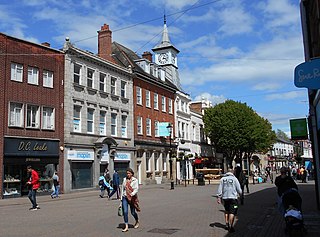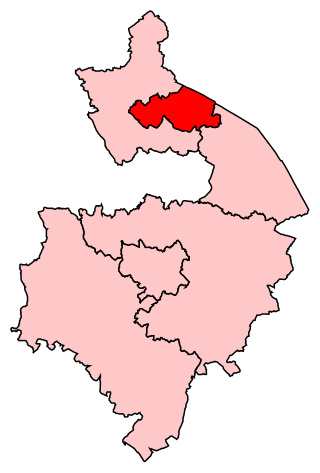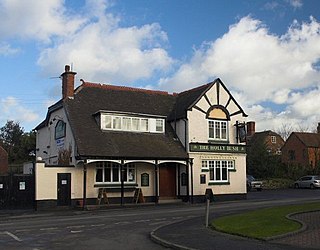
Nuneaton is a market town in the borough of Nuneaton and Bedworth in northern Warwickshire, England, close to the county border with Leicestershire and West Midlands County. Nuneaton's population at the 2021 census was 94,634, an increase from 86,552 at the 2011 census making it the largest town in Warwickshire.

Bedworth is a market town and unparished area in the borough of Nuneaton and Bedworth, Warwickshire, England. It is situated between Coventry, 6 miles to the south, and Nuneaton, 3 miles (5 km) to the north.

Warwickshire is a county in the West Midlands region of England. The county town is Warwick, and the largest town is Nuneaton. The county is famous for being the birthplace of William Shakespeare at Stratford-upon-Avon and Victorian novelist George Eliot,, at Nuneaton. Other significant towns include Rugby, Leamington Spa, Bedworth, Kenilworth and Atherstone. The county offers a mix of historic towns and large rural areas. It is a popular destination for international and domestic tourists to explore both medieval and more recent history.

North Warwickshire is a local government district with borough status in the ceremonial county of Warwickshire, West Midlands, England. Outlying settlements in the borough include the two towns of Atherstone and Coleshill. Notable villages in the borough include Dordon, Polesworth, Kingsbury, Water Orton and Shustoke.

Nuneaton is a constituency represented in the House of Commons of the UK Parliament since 2010 by Marcus Jones, a Conservative. Since 1997, the seat has been seen as an important national bellwether.

Arley is a civil parish in the North Warwickshire district of Warwickshire, England. The parish includes two settlements, New Arley and Old Arley. Old Arley is to the west of the Bourne Brook and the Birmingham to Peterborough Line, and New Arley is to the east. Nearby places are Ansley and Astley. Old Arley contains the medieval church of St Wilfred's, and a nearby Methodist church. New Arley contains St Michael's Church of England and St Joseph's Catholic Church. The two Anglican churches form one ecclesiastical parish, and St Joseph's is run from St Anne's.

The Coventry to Nuneaton Line is a railway line linking Coventry and Nuneaton in the West Midlands of England. The line has a passenger service. It is also used by through freight trains, and freight trains serving facilities on the route.

UK Coal Production Ltd, formerly UK Coal plc, was the largest coal mining business in the United Kingdom. The company was based in Harworth, in Nottinghamshire. The company was a constituent of the FTSE 250 Index. The successor company that contains the former property division, Harworth Group, is still listed on the London Stock Exchange.

Meden Vale is a small former coal mining village originally known as Welbeck Colliery Village prior to renaming in the late 1960s.

Hurley is a village in the Kingsbury civil parish of North Warwickshire, England. Other nearby places include Wood End, Hurley Common, Coleshill, Water Orton, Curdworth, Atherstone and Tamworth. According to the 2001 Census the population of the Hurley and Wood End ward was 3,642. Over 99.5% of people (3,550) described themselves as White British with only 92 people from other ethnic groups. The most common distance travelled to work is 5–10 kilometres (3.1–6.2 mi), which is essentially to Tamworth, with the most common form of employment being manufacturing. The village has an almost exact 50:50 split of males and females, with a ratio of 1,822 to 1,820 respectively.

Old Arley is a village in the civil parish of Arley, in the north of Warwickshire, England, 5.5 miles (8.9 km) west of Nuneaton and 10 miles (16 km) north west of the city of Coventry.

Holbrooks is a residential area of Coventry, West Midlands, England.
Piccadilly is a small village in the North Warwickshire district of the county of Warwickshire in England. It is located near to the larger village of Kingsbury, and is four miles south of Tamworth.

The Arbury Canals were a system of private canals, in the Arbury Estate, between Nuneaton and Bedworth in Warwickshire, England. They connected with the Coventry Canal. They were built by Sir Roger Newdigate between 1764 and 1795, and ceased to be used soon after his death in 1806. The Griff Hollows Canal was separate to the main system, and carried coal until its closure in 1961.
Kingsbury Colliery was a coal mine in Kingsbury, Warwickshire, which operated between 1897 and 1968.
The Warwickshire Coalfield extends between Warwick and Tamworth in the English Midlands. It is about 25 miles (40 km) from north to south and its width is around half that distance. Its western margin is defined by the 'Western Boundary Fault'. In the northeast it abuts against steeply dipping shales of Cambrian age. The larger part of the outcrop at the surface consists of the Warwickshire Group of largely coal-barren red beds. Until its closure in 2013, the Daw Mill mine near Arley within the coalfield, was Britain's biggest coal-producer in the 21st century.
Coventry Colliery was a coal mine located in the village of Keresley End in northern Warwickshire, between Bedworth and Coventry, England. Closed in 1991, the site today has been redeveloped as a distribution park, owned by Prologis.

Stockingford was a railway station serving the Stockingford area of Nuneaton in Warwickshire, England. It was opened by the Midland Railway on the Birmingham-Nuneaton-Leicester Line in 1864, and operated until closure in 1968.

Craig Paul Tracey is a British Conservative Party politician, who has been the Member of Parliament (MP) for North Warwickshire since his election in 2015. Originally from the North East, Tracey settled in North Warwickshire in 1997. After serving as a parish councillor he was selected as the Conservative Party's parliamentary candidate for North Warwickshire in 2014. He unexpectedly increased the Conservative majority in the constituency despite not being the favourite to win. A former member of the Business, Innovation and Skills Select Committee, Tracey has served as co-chair of the All Party Parliamentary Group for Insurance and Financial Services since July 2016.

















